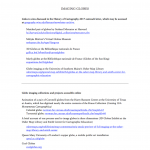 Additional information on digital imaging of globes
Additional information on digital imaging of globes
 (Download a print version of the “Imaging Globes” links and information below.)
(Download a print version of the “Imaging Globes” links and information below.)
Links to sites discussed in our most recent outreach letter (download a print version of the 2017 letter).
Matched pair of globes by Gerhard Mercator at Harvard
hcl.harvard.edu/collections/digital_collections/mercator.cfm
Mátyás Márton’s Virtual Globes Museum
terkeptar.elte.hu/vgm/?lang=en
3D Globes at the Bibliothèque nationale de France
gallica.bnf.fr/html/und/cartes/globes
Marly globes at the Bibliothèque nationale de France (Globes of the Sun King)
expositions.bnf.fr/globes/
Globe imaging at the University of Southern Maine’s Osher Map Library
oshermaps.org/special-map-exhibits/3d-globes-at-the-osher-map-library-and-smith-center-for-cartographic-education
Globe imaging collections and projects accessible online
Animation of a pair of Coronelli globes from the Harry Ransom Center at the University of Texas at Austin, which has digitized nearly the entire contents of the Kraus Collection (Catalog 124: Monumenta Cartographica)
Celestial globe: norman.hrc.utexas.edu/krausmaps/details.cfm?mapId=65
Terrestrial globe: norman.hrc.utexas.edu/krausmaps/details.cfm?mapId=66
A brief account of one process used to image globes in three dimensions (3D Globes Exhibit at the Osher Map Library and Smith Center for Cartographic Education)
Queen Mary University of London’s copper globe, a mobile public art installation
Cool Globes
Maps featured in the outreach letter
Looking at old globes from the right angle can make the Earth look like Saturn, as shown by the detail of this 1787 globe on the front of History of Cartography Project’s 2017 outreach letter.
Charles Francois Delamarche, Globe Dresse par M. Robert de Vaugondy, geographe, corrige, augmente, et enrichi des trois voyages de Capitaine Cook et de ses decouvertes/par Delamarch, Geogr., 1787. Portland, Osher Map Library and Smith Center for Cartographic Education, University of Southern Maine, Smith Collection SM-1787-8).
oshermaps.org/browse-maps?id=13610
There is an entire genre of nineteenth-century globes that unfolded or expanded like umbrellas to be displayed with a flourish to capture the attention of children and to be stored safely. The genre is discussed by Volume Six editor Mark Monmonier Volume Six editor Mark Monmonier in his most recent book, Patents and Cartographic Inventions (Cham: Palgrave Macmillan, 2017).
Dennis Townsend, Townsend’s Patent Folding Globe (Boston: George M. Smith & Co., 1870). Norman B. Leventhal Map Center Collection, Boston Public Library.
collections.leventhalmap.org/search/commonwealth:6t053q90k
Willem Jansz. Blaeu pioneered the commercial market for globes in Amsterdam, beginning in 1599, producing pairs of terrestrial and celestial globes that together modeled the entire cosmos. He mostly produced smaller, cheaper globes, from two to nine inches in diameter (this one is six inches), but also two larger sets at 13.5 and 26 inches.
Willem Jansz. Blaeu, Sphæra stellifera, 1606. Portland, Osher Map Library and Smith Center for Cartographic Education, University of Southern Maine, Smith Collection.
Globe: oshermaps.org/map/2320.0001
Ball: oshermaps.org/map/2320.0217
Stand: oshermaps.org/map/2320.0457
The British map publisher, James Wyld, proposed the construction of his great géorama as both an extension of the great Crystal Palace Exhibition that opened in 1851 and as a means to redeem the run-down and unsavory Leicester Square. In the notice accompanying the image, Wyld was reported to have “recollect[ed] that only a limited part of the sphere can meet the eye at once,” and so had thought that “by figuring the earth’s surface on the interior instead of the exterior of his globe, the observer would be enabled to embrace the distribution of land and water, with the physical features of the Globe, at one view.” His “Model of the Earth” was constructed so that each degree of longitude around the equator was six inches long, giving a diameter of about sixty feet. The great globe drew large crowds, but Wyld tore it down at the end of his lease in 1862.
“Mr. Wyld’s Model of the Earth. Sectional View.” Illustrated London News 18 (7 June 1851): 511.
babel.hathitrust.org/cgi/pt?id=mdp.39015027902827;view=1up;seq=495;size=150
Visit our newsletter archive.
